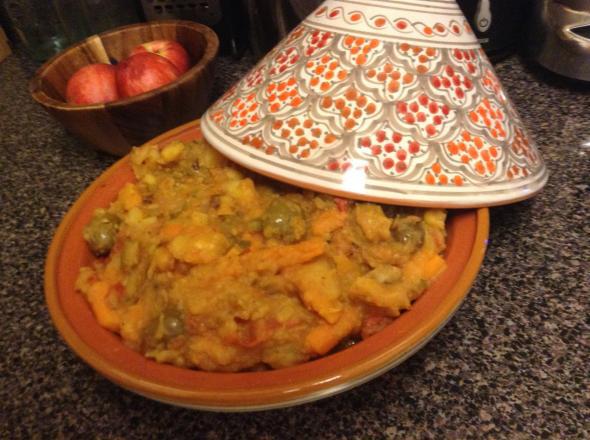Since I grew up in a half-Sephardic household, the Jewish High Holidays of Rosh Hashanah and Yom Kippur meant to me something different from what they meant to my mainly Ashkenazi Hebrew school classmates. Sephardim are Jews that settled in Southern Europe and Northern Africa after the Diaspora. Ashkenazi Jews are from Eastern Europe and Russia, and they make up the vast majority of the American Jewish population. As opposed to heavily Russian-influenced Ashkenazi fare, Sephardic food takes on a Mediterranean flavor, borrowing traditions from North African Muslim communities and Southern Europe. It uses lots of lemon, and olives, and olive oil, and lentils, and lamb, and chickpeas, and nuts, and fresh and dried fruits. Sephardic cuisine, to me, does more with spices, heat, and flavors than Ashkenazi cuisine.
So while my mostly Ashkenazi Hebrew schoolmates were eating gefilte fish, kugel, and matzo ball soup for the major Jewish holidays (we had token versions of some of these at our table to please my Ashkenazi father), my French Moroccan mother was serving up boulettes (stewed Moroccan meatballs), salade cuite (cooked red pepper and tomato salad served cold), and triangles (deep-fried, salty, triangle-shaped French pastries stuffed with beef—as good as they sound). The star of the show was always a fresh Moroccan-style couscous with all of the trimmings—baked squash, turnips, and carrots all sprinkled with cinnamon, slow-cooked chickpeas, and a lamb-stewed gravy.
Now if I had the abilities and wherewithal of my mother or my grandfather to spend hours in the kitchen perfecting all of these wonderful dishes, I probably would. (My mom always does all of the holiday cooking—my father only knows how to make two things: LEO and boiled hot dogs). As it is, I’ve only really mastered one of my mother’s classic Sephardic recipes, but it happens to be the easiest to make, and I’ve also found it to be the easiest to make for vegetarians.
If you’re planning your Rosh Hashanah meal this year and you want to try something different—or if you’re just looking for a new, hearty fall recipe—I recommend attempting to make a tagine. A traditional Moroccan stew, tagine is usually a slow-cooked meat dish made in a traditional clay pot. There are lots of different varieties of tagine including tagine d’agneau aux pruneaux (sweet lamb with prunes and nuts), tagine d’agneau aux dattes (the same, but with dates), tagine de poulet aux citrons (lemon chicken), and tagine de poulet aux olives (olive and lemon chicken).
You may have noticed that none of these sound particularly vegetarian, or for that matter fast and easy to make. Tagine can be labor and time intensive when done in the traditional manner—my great-grandmother apparently used to pickle her lemons for her lemon chicken recipe for weeks at a time. When you make tagine in the traditional-style by slow-cooking it in a clay tagine pot, the dish also requires a fancy and somewhat expensive piece of specialty cookware. I recently bought a clay tagine pot for $60, and I find that I make the dish enough for it to be worth it to me. For years, though, I made tagine without a tagine pot, without hours of slow-cooking, and without meat, and it has become one of my vegetarian wife’s favorite dishes. It’s easy enough to make that it is no longer just a holiday dish in our household. I’m a massive carnivore, and I find the vegetarian version of Moroccan olive chicken as satisfying as the chicken version.
Here’s how to make a traditional Moroccan tagine for the Jewish holidays (or any other occasion) without the traditional clay pot, the traditional meat, or the traditional hours of cooking.
Vegetarian Poulet aux Olives Tagine (sans Poulet)
Yield: 4 to 6 servings
Time: 90 minutes
¼ cup extra-virgin olive oil, plus more if needed
2 onions, chopped
5 garlic cloves, minced
10 medium yellow potatoes, peeled and chopped
5 carrots, peeled and chopped
Salt and black pepper
5 small Roma tomatoes, chopped
1 medium fresh jalapeño or other chili pepper, seeded if desired and minced, or a dash of crushed red pepper
2 large lemons, halved
One 12-ounce jar pitted green olives or jalapeño-stuffed green olives
Cooked couscous for serving
1. Put the olive oil in a large stew pot over medium heat. When it’s hot, add the onion and garlic and cook, stirring occasionally, until golden brown, 7 to 10 minutes.
2. Add the potatoes and carrots, season with salt and pepper, and continue to cook, stirring regularly to try to keep the potatoes from sticking to the bottom of the pot, for 15 minutes. Add about a tablespoon of olive oil or water if the mixture starts to appear dry and stick to the bottom of the pot.
3. Add the tomatoes and chili pepper, and cook until the tomatoes start to break down, about 15 minutes. Add the olives along with all their liquid. Squeeze the lemons’ juice into the pot and then stir in the rinds. Make sure all the ingredients are covered with liquid; if not, add a little more water. Cover the dish and cook, lifting the lid to stir every few minutes, until the olives are soft, 20 to 30 minutes. Remove the lemon rinds, and taste and adjust the seasoning. Serve with apples and honey on the side, depending on the occasion.
Previously in You’re Doing It Wrong:
Bruschetta
Jalapeños
Curd
Cornbread
Raspberries
Granola Bars
Paella
Quinoa
